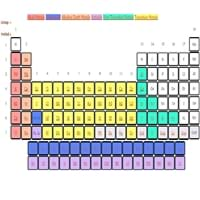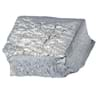Calcium Curium Comparison
Periodic Table
Symbol
Ca
Cm
Group Number
2
16
Not Available
Period Number
4
7
Block
s block
f block
Element Family
Alkaline Earth
Actinide
CAS Number
7440702
21
7440519
36
Space Group Name
Fm_ 3m
Not Available
Space Group Number
225.00
2
Not Available
Facts
Interesting Facts
- Calcium ranks 5th rank in the list of earth’s abundance Percentage.
- It is found in the compound state.
- Gypsum or calcium sulfate is used as plaster and plaster of paris.
- Curium metal does not occur free in nature.
- Curium metal is a synthetically produced metal.
Sources
Earth's crust, Found in Minerals, Mining, Ores of Minerals
Bombarding Plutonium with Helium Ions
History
Who Discovered
Humphry Davy
Glenn T. Seaborg, Ralph A. James, Albert Ghiorso
Discovery
In 1808
In 1944
Abundance
Abundance In Universe
7 * 10-3 %
3
Not Available
Abundance In Sun
~0.007 %
4
~-9999 %
Abundance In Meteorites
1.10 %
4
Not Available
Abundance In Earth's Crust
5.00 %
3
Not Available
Abundance In Oceans
0.00 %
5
Not Available
Abundance In Humans
1.40 %
1
Not Available
Uses
Uses & Benefits
- It is used as a reducing agent while preparing metals like thorium and uranium. It is also used as an alloying agent for metals such as aluminum, copper & lead.
- Calcium carbonate or lime stone is used in cement.
- Curium metal is used to provide power to electrical equipment for space missions.
Industrial Uses
Chemical Industry
NA
Medical Uses
Dentistry, Pharmaceutical Industry
NA
Other Uses
Alloys
Research Purposes
Biological Properties
Toxicity
Non Toxic
Unknown
Present in Human Body
Yes
No
In Blood
60.50 Blood/mg dm-3
4
0.00 Blood/mg dm-3
37
In Bone
170,000.00 p.p.m.
1
0.00 p.p.m.
36
Physical Properties
Melting Point
839.00 °C
99+
1,340.00 °C
34
Boiling Point
1,484.00 °C
99+
3,110.00 °C
30
Appearance
Physical State
Solid
Solid
Color
Gray
Silver
Luster
NA
Metallic
Hardness
Mohs Hardness
1.75
17
Not Available
Brinell Hardness
170.00 MPa
99+
Not Available
Speed of Sound
3,810.00 m/s
19
Not Available
Optical Properties
Allotropes
No
No
α Allotropes
Not Available
Not Available
β Allotropes
Not Available
Not Available
γ Allotropes
Not Available
Not Available
Chemical Properties
Chemical Formula
Ca
Cm
Isotopes
Known Isotopes
19
20
15
24
Electronegativity
Pauling Electronegativity
1.00
99+
1.30
32
Sanderson Electronegativity
0.95
24
Not Available
Allred Rochow Electronegativity
1.04
34
1.20
27
Mulliken-Jaffe Electronegativity
1.08
17
Not Available
Allen Electronegativity
1.03
39
Not Available
Electropositivity
Pauling Electropositivity
3.00
9
2.70
22
Ionization Energies
1st Energy Level
589.80 kJ/mol
99+
581.00 kJ/mol
99+
2nd Energy Level
1,145.40 kJ/mol
99+
1,196.00 kJ/mol
99+
3rd Energy Level
4,912.40 kJ/mol
7
2,026.00 kJ/mol
99+
4th Energy Level
6,491.00 kJ/mol
7
3,550.00 kJ/mol
99+
5th Energy Level
8,153.00 kJ/mol
7
Not Available
6th Energy Level
10,496.00 kJ/mol
8
Not Available
7th Energy level
12,270.00 kJ/mol
12
Not Available
8th Energy Level
14,206.00 kJ/mol
15
Not Available
9th Energy Level
18,191.00 kJ/mol
12
Not Available
10th Energy Level
20,385.00 kJ/mol
16
Not Available
11th Energy Level
57,110.00 kJ/mol
3
Not Available
12th Energy Level
63,410.00 kJ/mol
3
Not Available
13th Energy Level
70,110.00 kJ/mol
3
Not Available
14th Energy Level
78,890.00 kJ/mol
4
Not Available
15th Energy Level
86,310.00 kJ/mol
5
Not Available
16th Energy Level
94,000.00 kJ/mol
6
Not Available
17th Energy Level
104,900.00 kJ/mol
7
Not Available
18th Energy Level
111,711.00 kJ/mol
8
Not Available
Electrochemical Equivalent
0.75 g/amp-hr
99+
3.07 g/amp-hr
16
Electron Work Function
2.87 eV
38
Not Available
Other Chemical Properties
Chemical Stability, Flammability, Ionization, Solubility
Ionization, Radioactive Isotopes
Atomic Properties
Atomic Number
20
99+
96
22
Electron Configuration
[Ar] 4s2
[Rn] 5f7 6d1 7s2
Crystal Structure
Face Centered Cubic (FCC)
Double Hexagonal Close Packed (DHCP)
Crystal Lattice
FCC-Crystal-Structure-of-Calcium.jpg#100
DHCP-Crystal-Structure-of-Curium.jpg#100
Atom
Number of Protons
20
99+
96
22
Number of Neutrons
20
99+
151
10
Number of Electrons
20
99+
96
22
Radius of an Atom
Atomic Radius
197.00 pm
6
174.00 pm
20
Covalent Radius
176.00 pm
22
169.00 pm
26
Van der Waals Radius
231.00 pm
19
200.00 pm
28
Atomic Weight
40.08 amu
99+
247.00 amu
18
Atomic Volume
29.90 cm3/mol
7
18.28 cm3/mol
26
Adjacent Atomic Numbers
Valence Electron Potential
29.00 (-eV)
99+
44.50 (-eV)
38
Lattice Constant
558.84 pm
9
Not Available
Lattice Angles
π/2, π/2, π/2
NA
Lattice C/A Ratio
Not Available
Not Available
Mechanical Properties
Density
Density At Room Temperature
1.55 g/cm3
99+
13.51 g/cm3
25
Density When Liquid (at m.p.)
1.38 g/cm3
99+
13.85 g/cm3
10
Tensile Strength
Not Available
Not Available
Viscosity
Not Available
Not Available
Vapor Pressure
Vapor Pressure at 1000 K
25.50 (Pa)
3
Not Available
Elasticity properties
Shear Modulus
7.40 GPa
99+
Not Available
Bulk Modulus
17.00 GPa
99+
Not Available
Young's Modulus
20.00 GPa
99+
Not Available
Poisson Ratio
0.31
13
Not Available
Other Mechanical Properties
NA
Unknown
Magnetic Properties
Magnetic Characteristics
Specific Gravity
4.58
99+
13.51
17
Magnetic Ordering
Diamagnetic
Antiferromagnetic
Electrical Properties
Electrical Property
Conductor
Unknown
Resistivity
33.60 nΩ·m
99+
1.25 nΩ·m
99+
Electrical Conductivity
0.30 106/cm Ω
6
Not Available
Electron Affinity
2.37 kJ/mol
39
Not Available
Thermal Properties
Specific Heat
0.63 J/(kg K)
7
Not Available
Molar Heat Capacity
25.93 J/mol·K
34
Not Available
Thermal Conductivity
201.00 W/m·K
5
Not Available
Critical Temperature
Not Available
Not Available
Thermal Expansion
22.30 µm/(m·K)
19
Not Available
Enthalpy
Enthalpy of Vaporization
150.00 kJ/mol
99+
Not Available
Enthalpy of Fusion
8.54 kJ/mol
99+
15.00 kJ/mol
21
Enthalpy of Atomization
184.00 kJ/mol
99+
Not Available
Standard Molar Entropy
41.60 J/mol.K
36
Not Available
|
||
|
||
|












